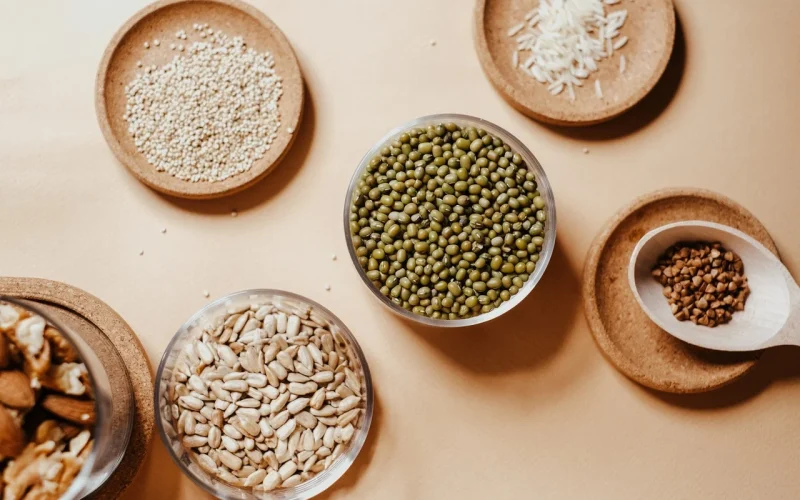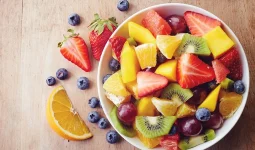All around the world, families eat grains as a staple diet. They are composed of the bran, the nutrient-rich outer layer; the germ, the nutrient-rich embryo of the seed; and the endosperm, the germ’s main source of starchy carbohydrates.
Simply said, whole grains are those that still have all three components. They often include high dietary fiber, B vitamins, selenium, phosphorus, magnesium, manganese, and iron.
It’s interesting to note that consuming whole grains instead of processed grains has been associated with a decreased risk of heart disease, type 2 diabetes, cancer, and other diseases.
Here is a list of the different types of whole grains that are nutritious.
1. Whole Wheat
A popular and highly adaptable cereal grain is whole wheat. It is an important ingredient in couscous, bulgur, semolina, pasta, and baked foods.
Wheat is incredibly popular, but since it contains gluten, it is also quite controversial. In certain people, the protein gluten might set off a negative immunological reaction.
Whole wheat is a terrific addition to your diet if, like most people, you can handle gluten since it’s a great source of antioxidants, vitamins, minerals, and dietary fiber.
Make sure you only choose items marked “whole wheat,” not simply “wheat.” Whole wheat includes the whole grain, including the endosperm, bran, and fibrous husk. On the other hand, the nutrient-rich husk and bran are removed from regular wheat.
2. Whole Oats
Oats contain polyphenols, which have potent anti-inflammatory and antioxidant properties. Additionally, they contain a lot of beta-glucan, a soluble fiber that lowers LDL (bad) cholesterol and may cut the risk of several cancers.
Additionally, oats could reduce blood pressure. Fiber, iron, magnesium, phosphorus, zinc, copper, thiamin, manganese, and selenium are all present in considerable amounts in them.
Although oats are inherently gluten-free, they may be processed with other grains that do, so be sure to look for the gluten-free certification on the label. Whole Oats are one of the best different types of whole grains.
3. Millet
This Asian grain without gluten produces congee, stir-fried food, and porridge. Uncooked millet has 210 calories, 42 grams of carbohydrates, 3 grams of dietary fiber, and 5 grams of protein per quarter cup.
In addition to being a strong source of magnesium, phosphorus, copper, thiamin, and niacin, millet is also high in antioxidants and manganese.
4. Corn
Corn is often known as maize among the very well-liked different types of whole grains (Zea mays). It is cultivated in larger amounts than wheat and rice and is a staple food worldwide.
Manganese, magnesium, zinc, copper, phosphorus, potassium, B vitamins, and antioxidants are abundant in whole, unprocessed maize.
It is naturally free of gluten. Antioxidants prevalent in yellow corn include lutein and zeaxanthin, which are found in maize.
These antioxidants have been linked to a lower risk of macular degeneration and cataracts, two of the main causes of blindness, according to several studies.
Additionally, maize has a healthy quantity of fiber. Yellow maize cooked has 4.6 grams of fiber per cup (164 grams) or 18% of the Daily Value (DV).
5. Teff
Teff is Ethiopia’s smallest grain and the major component in Injera bread. Along with amaranth, it has a high protein content.
Teff has 180 calories, 37 grams of carbohydrates, 4 grams of dietary fiber, and 7 grams of protein in one-quarter cup of uncooked teff.
It is free of gluten and a great source of magnesium and iron. Additionally, teff contains a significant amount of fiber, iron, magnesium, phosphorus, zinc, thiamin, and vitamin B6. It may also provide more than 100% of the recommended daily manganese intake.
6. Buckwheat
This is one of the different types of whole grains that is naturally gluten-free and often used as cereal (kasha), in Japanese noodles (soba noodles), granola, pancakes, or crepes. It has antioxidants linked to the reduction of heart disease and cancer risk.
Not all grain is digested; thus, the soluble fiber in buckwheat may help lower blood cholesterol and regulate blood sugar.
160 calories, 34 grams of carbs, 5 grams of dietary fiber, and 5 grams of protein are included in one-quarter cup of uncooked grain. Additionally rich in magnesium, copper, and manganese is buckwheat.
7. Whole Rye
According to nutritional research by the non-profit The Organic Center, rye provides more nutrients per 100 calories than any other whole grain.
It contains about 50% of the required iron intake and has four times the fiber of regular whole wheat.
One issue is that most rye and pumpernickel bread sold in supermarkets is produced with refined flour. To get the beneficial health effects, be persistent and check for “whole rye” at the top of the ingredients list.
8. Brown Rice
When you select white rice over brown rice, around 75% of its nutrients are lost, including almost all of the antioxidants, magnesium, phosphorus, and B vitamins in the nutritious bran and germ.
Choose brown rice wherever feasible, including brown, fragrant basmati, and jasmine. Red and black rice, regarded as whole grains and rich in antioxidants, will make your meal even more exotic.
Wild rice is a complete grain and high in B vitamins like niacin and folate, even though it is technically grass.
9. Freekeh
This Arabic grain is a low-carb variety of ancient wheat that contains up to four times more fiber than brown rice. Freekeh kernels are collected when they’re fresh and then roasted.
Compared to other different types of whole grains, they are higher in vitamins and minerals like selenium, which helps the immune system.
Once in your stomach, freekeh serves as a prebiotic, supporting the development of good bacteria that promote digestion. Look for it at Middle Eastern markets, natural food shops, and on Amazon.
10. Farro
The grain farro is well-known in Italy and the Mediterranean region. Traditional farro, which isn’t processed, and pearled farro, which is treated to cook more quickly, are the two primary varieties. It has a robust, chewy, and nutty taste.
The dietary fiber-rich grain may be used in salads, soups, and rice substitutes. 200 calories, 37 grams of carbs, 7 grams of dietary fiber, and 7 grams of protein are included in one-quarter cup of dry, uncooked farro.
11. Quinoa
This South American grain is a favorite among meal preppers since it normally cooks in about 15 minutes. Quinoa is also very nourishing since it is a source of full vegetable protein and has all nine necessary amino acids.
Compared to other grains, it also has more protein and fewer carbs. Magnesium, phosphorus, manganese, and folic acid are all abundant in quinoa.
Uncooked quinoa has 170 calories, 29 grams of carbs, 3 grams of fiber, and 6 grams of protein in a quarter cup.
For a healthy supper, combine some quinoa with sweet potatoes, kale, and pesto. This is one of the best different types of whole grains.
12. Bulgur
Although up to 5% of its bran may be removed during processing, bulgur is theoretically still regarded as a whole grain. The grain is a fantastic source of magnesium and iron and is used to produce tabbouleh salad.
The fiber and protein powerhouse may be added to salads, which provide 25% of the recommended daily protein intake and almost 75% of the dietary fiber you need for the day. Plus, it cooks in a short amount of time.
13. Whole Barley
Traditional barley dishes include soups, salads, grain bowls, and more. It offers more nutritional fiber per meal than any other grain and a variety of phytonutrients, including the soluble fiber beta-glucan.
This is one of the best different types of whole grains. These antioxidants could improve immunity and lower harmful cholesterol.
Uncooked, hulled barley has 8 grams of dietary fiber, 6 grams of protein, 34 grams of carbs, and 160 calories per quarter cup. The amount of manganese, selenium, and thiamine is also high (a B vitamin).
14. Amaranth
Amaranth is a bit gluten-free whole grain. It has between 14 and 15 percent protein, more than buckwheat and rye. It is rich in magnesium, manganese, and phosphorus and contains phytochemicals.
Amaranth has 6 grams of nutritional fiber, 7 grams of protein, and 200 calories in a quarter cup of uncooked grain.
15. Spelt
The cultivation of spelt dates back thousands of years and is one of the best different types of whole grains. Spelt is a high source of manganese, magnesium, phosphorus, zinc, iron, B vitamins, and fiber and is nutritionally comparable to modern whole wheat. It is also a type of whole wheat.
However, compared to whole wheat, it provides a little bit more zinc and protein. Spelt includes antinutrients like phytic acid, which may hinder zinc and iron absorption from your stomach, as all other grains do.
Adults eating a balanced diet don’t need to worry too much about this since other foods include more zinc and iron, but vegetarians and vegans may have issues with it.
Fortunately, sprouting, fermenting, or soaking the grains may help minimize antinutrients. Additionally, it’s crucial to remember that spelt includes gluten and is incompatible with a gluten-free diet.
16. Whole-Grain and Whole-Wheat Pastas
The whole wheat grain is used to make whole-grain pasta. They thus include more fiber, vitamins, and minerals than regular pasta. For instance, compared to regular spaghetti, whole-grain spaghetti has 2.5 times more fiber.
Whole-grain pastas tend to be more filling since they include more fiber. They are, however, produced from whole-wheat flour that has been finely ground.
As a result, many of the nutritional benefits of whole grains are diminished, making whole-grain pasta less nutritious than diets made entirely of whole grains like quinoa and brown rice.
However, whole-grain pasta is preferable to normal pasta if you decide to consume it since the former includes more satisfying fiber, more nutrients, and fewer calories.








